Municipal vales
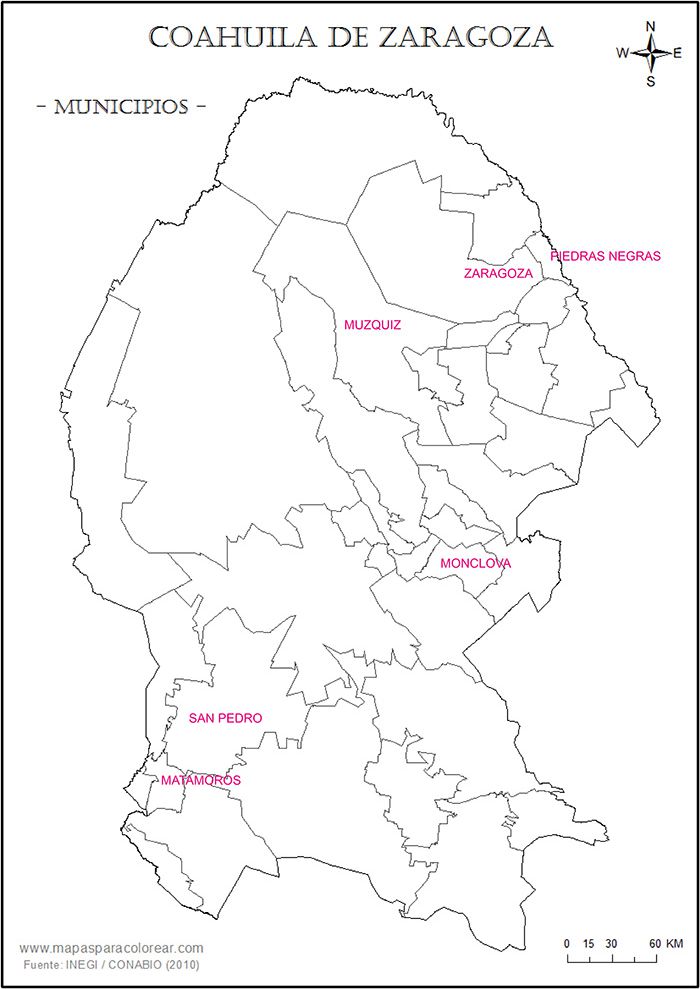
Piedras Negras
At some time in 1913 or 1914 the local treasury issued a series of vales[images needed] to facilitate commercial transactions. On 3 September 1914 Manuel Cepeda gave businesses and the general public a month to hand in any notes they still held, to be exchanged for Gobierno Constitucionalista notesPeriódico Oficial, Tomo XXIII, Núm. 13, 12 September 1914. The text of Cepeda's notices, referring to these as tarjetas "VALES", put into circulation, suggests that this was an issue of paper currency rather than mere chits.
Zaragoza
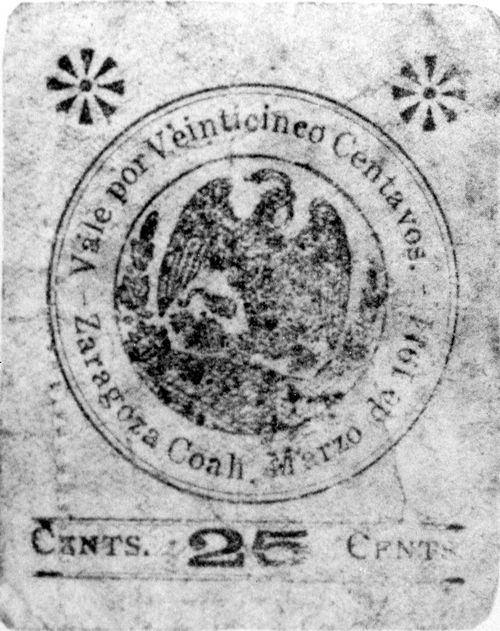 M1184 25c Zaragoza
M1184 25c Zaragoza
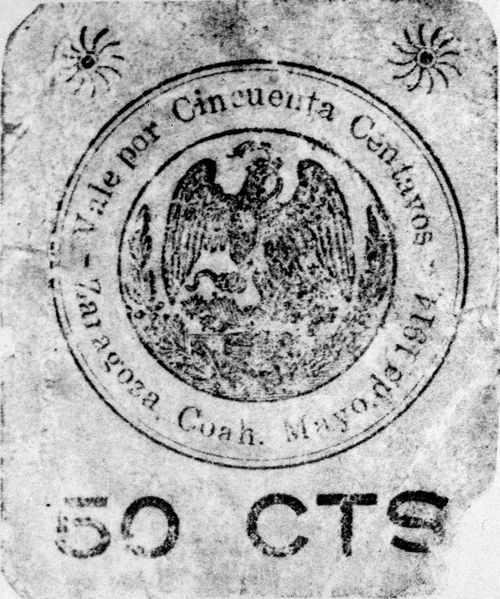 M1185 50c Zaragoza
M1185 50c Zaragoza
This is probably a municipal issue. Two values, dated March and May 1914, are known. On the reverse of the 25c note is an illegible seal, embossed city and state name and the hand signature of J. MartínezRichard A Long, Mail Auction Sale, July 28, 1975.
Múzquiz
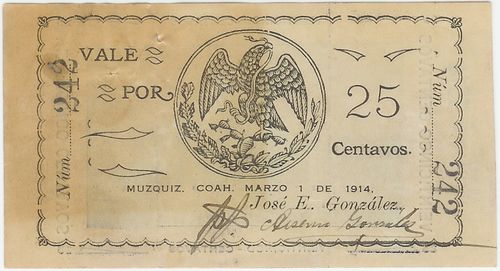
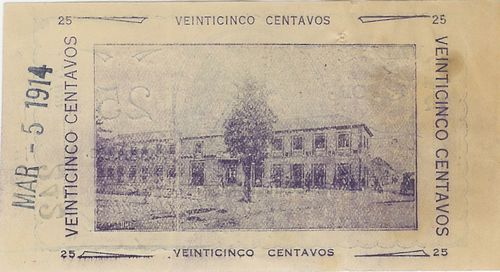 M1135 25c Múzquiz
M1135 25c Múzquiz
| date on note | from | to | total number |
total value |
||
| 25c | 5 March 1914 | includes number 242 |
This could well be a municipal issue, with José E. González the [ ] and the building one on the main square, which was functioning as a school in 1905 and since 1984 has housed the Museo Histórico de Múzquiz. The note is signed by Arsenio González, as per pro José E. González.
|
Arsenio González On 17 February 1912 the governor Venustiano granted an Arsenio González of Muzquiz an exemption from taxes for the $10,000 that he was going to invest in an ice plantACoah, FD, caja 59, folleto 4, exp. 11. Later in 1920 he was granted a contract to build a flour millXXIV Legislatura (1920-1921) Gobernación , exp 44, decreto 467. |
 |
Monclova
Because of the lack of small change during the Revolution, Monclova, like many other cities, had recourse to issue its own fractional currency.
First issue
Firstly, on 23 May 1914 the interim Presidente Municipal, J. G. Blackaller, told his tesorero municipal that General Francisco Murguía, the local Jefe de Armas, had authorized them to issue $4,000 in notes of 10, 25 and 50 centavos[images needed]. They were to be guaranteed by a deposit of notes, for when holders wanted to redeem themAMMon, Fondo Tesoreria, 1914. Since a later letter refers to $6,000 issued in May and July of 1914 we can presume that this first issue proved insufficient and a further $2,000 was issued in July 1914AMMon, Fondo Presidencia Municipal, caja 414, Libro copiador de oficios, pag. 212.
| from | to | total number |
total value |
||
| 10c | |||||
| 25c | |||||
| 50c | |||||
| $ 6,000 |
Second issue
Then in January 1915 the Jefe de Armas, Coronel Roberto Rivas, authorized a new issue of $10,000 in the following denominations:
| total number |
total value |
|
| 5c | 40,000 | $2,000 |
| 10c | 20,000 | 2,000 |
| 20c | 15,000 | 3.000 |
| 50c | 6,000 | 3,000 |
| $10,000 |
These were to be of forced circulation within the municipalityAMMon, Fondo Presidencia Municipal, caja 414, Libro copiador de oficios, pag. 42.
However, all the subsequent correspondence refers to just two denominations, 50c and one peso[image needed].
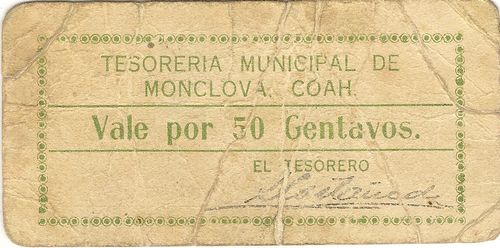 M1082 50c Tesorería Municipal
M1082 50c Tesorería Municipal
| from | to | total number |
total value |
||
| 50c | unnumbered | ||||
| $1 | unnumbered | ||||
| $ 7,000 | |||||
On 15 January Presidente Municipal Pedro V. Elizondo sent his tesorero, Salvador Castañeda, $4,248.90 (sic) in cartones of 50c and one peso, for the latter to sign and seal with the Treasury sealAMMon, Fondo Presidencia Municipal, caja 414, Libro copiador de oficios, pag. 37, and on 21 January sent a further $2,600AMMon, Fondo Presidencia Municipal, caja 414, Libro copiador de oficios, pag. 42.
| Salvador Castañeda |  |
On the arrival of the Villistas on 26 January Presidente Municipal Pedro Elizondo had fled to Piedras Negras, leaving Jacinto Cantú in his placeHe returned on 22 September 1915 (AMMon, Fondo Presidencia Municipal, caja 414, Libro copiador de oficios, pag. 281 Pedro Elizondo to Governor Espinoza Mireles, Saltillo, 25 September 1915). During their stay the Villistas took $6,543.73 from the Municipal TreasuryAMMon, Fondo Presidencia Municipal, caja 414, Libro copiador de oficios, pag. 295.
On 2 April the Tesorero Municipal listed $5,111.50 worth of notes that he had that were no longer legal tender, some of which related to the guarantee fund for the valesAMMon, Fondo Presidencia Municipal, caja 414, Libro copiador de oficios, pag. 138. ThePresidente Municipal asked Saltillo if these could be exchanged for valid notesAMMon, Fondo Presidencia Municipal, caja 414, Libro copiador de oficios, pag. 140 Jacinto Cantú to José Mena, Saltillo, 5 April 1915.
On 5 April the Presidente Municipal told Saltillo that they had issued $7,000 in 50c and $1 tarjetas, which circulated freely and were accepted for taxes. He asked the Governor to confirm the notes’ legality as to do otherwise would cause great hardship to the local government and publicAMMon, Fondo Presidencia Municipal, caja 414, Libro copiador de oficios, pag. 139.
When it came to redeeming these notes in April 1915 the Presidente Municipal asked the state governor, General Santiago Ramírez García, for a donation of $7,000. Why did he need help in redeeming an issue that was supposedly guaranteed by funds in the Treasury? Presumably because when the Villista “hordes” evacuated Monclova they took the money that was in the Treasury’s safe.
On 8 April Jacinto Cantú asked Saltillo to entrust the $7,000 to his Tesorero Municipal, Salvador Castañeda AMMon, Fondo Presidencia Municipal, caja 414, Libro copiador de oficios, pag. 146 Jacinto Cantú to José Mena, 8 April 1915. The Presidente Municipal acknowledged receipt of the money on April 14 and prohibited the circulation of the valesAMMon, Fondo Presidencia Municipal, caja 414, Libro copiador de oficios, pag. 150. (On 28 April the Presidente Municipal of Monclova wrote that businesses and the public were refusing the 5c, 10c and 20c notes (tarjetas transitorio) and asked for authorization to enforce their circulation and impose penalties, to which the governor agreed on the next dayACOAH, exp. 11707 (not found on visits in 2010 and 2017) but the reference to a 20c tarjeta suggests that these were [ ]). However, on 30 April the Tesorero Municipal was instructed to begin withdrawing the valesAMMon, Fondo Presidencia Municipal, caja 414, Libro copiador de oficios, pag. 169 Presidente Municipal to Tesorero Municipal, Monclova, 30 April 1915. So these had a short life and are correspondingly rare. Only the 50c note is known to have survived.
San Pedro
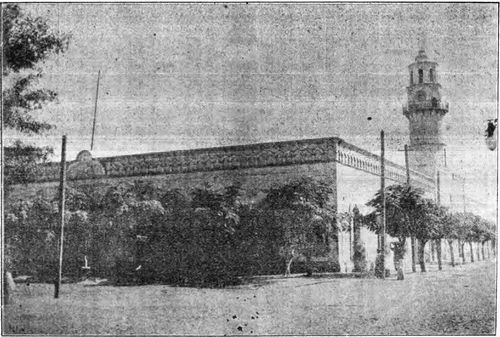
Presidencia Municipal, San Pedro
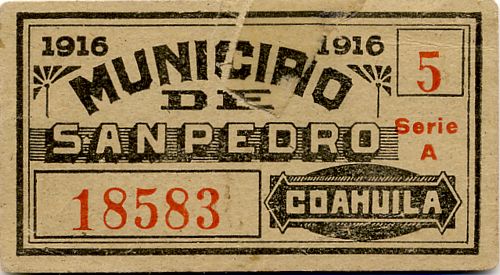
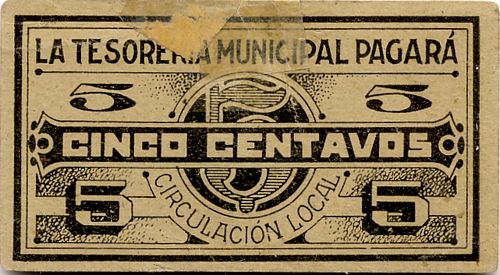 M1093 5c Municipio de San Pedro
M1093 5c Municipio de San Pedro
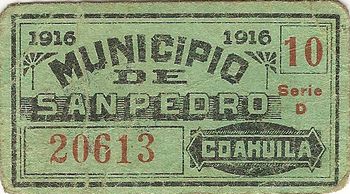 M1094 10c Municipio de San Pedro
M1094 10c Municipio de San Pedro
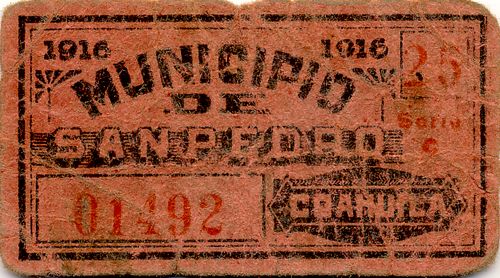
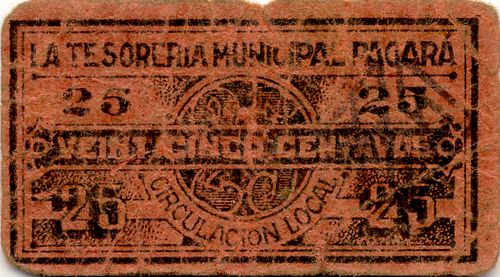 M1095 25c Municipio de San Pedro
M1095 25c Municipio de San Pedro
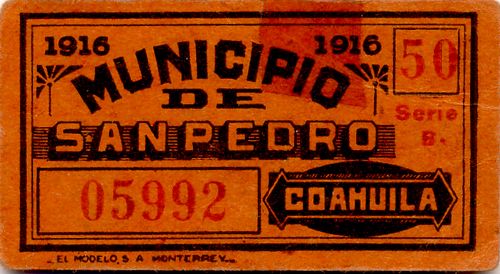
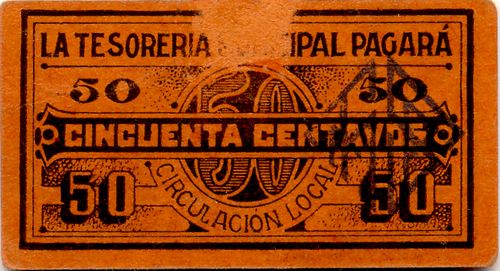 M1096 50c Municipio de San Pedro
M1096 50c Municipio de San Pedro
| series | to | from | total number |
total value |
||
| 5c | A | includes numbers 12218 to 266618CNBanxico #119 | ||||
| 10c | D | includes numbers 01492 to 20613 | ||||
| 25c | C | includes numbers 03439https://mediateca.inah.gob.mx/repositorio/islandora/object/fotografia%3A191562 to 18825 | ||||
| 50c | B | includes numbers 05992 to 15708 |
A later issue, dated 1916, for local circulation, printed by El Modelo in Monterey.
Matamoros
A local issue of three denominations, guaranteed by hodlings in the Tesorería Municipal.
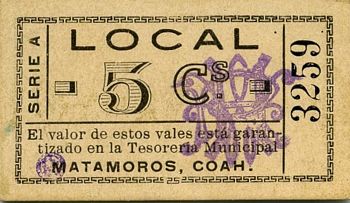
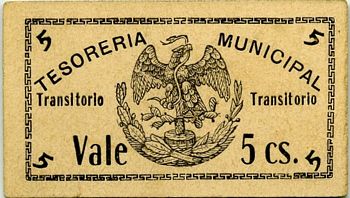 M1077 5c Tesorería Municipal
M1077 5c Tesorería Municipal
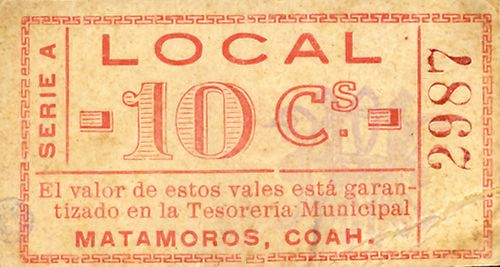
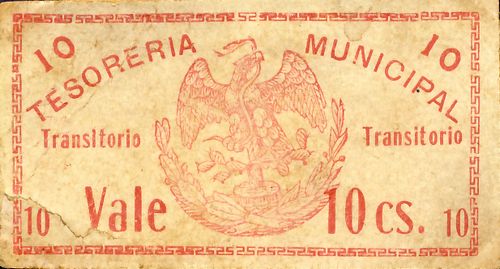 M1078 10c Tesorería Municipal
M1078 10c Tesorería Municipal
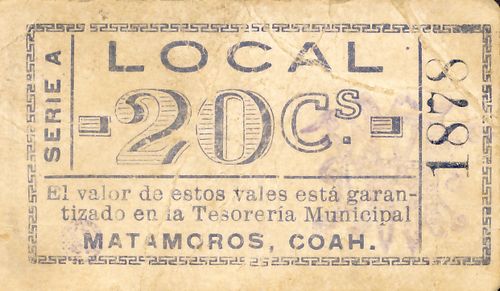
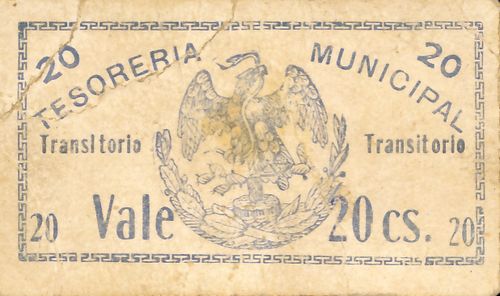 M1079 20c Tesorería Municipal
M1079 20c Tesorería Municipal
| series | to | from | total number |
total value |
||
| 5c | A | includes numbers 558 to 3259 | ||||
| 10c | A | includes numbers 2806CNBanxico #10202 to 2987 | ||||
| 20c | A | includes numbers 352CNBanxico #31 to 2259CNBanxico #10203 |
Torreón
On 1 December 1913 Dr. Adolfo Mondragon Bouckhardt, the Presidente Municipal of Torreón, wrote to the Comisión de Hacienda asking (if it was not inconvenient) to send the Presidencia the stamp (sello marcador) to stamp the paper money that the Tesorería Municipal was going to issueLG papers, 3-B-59: letter Presidente Municipal, Torreón, to Comisión de Hacienda, Torreón. 1 December 1913.
Is this an unrecorded municipal issue, or was Dr. Bouckhardt referring to the notes of the Comisión de Hacienda of the División del Norte which had the stamp of the Presidencia Municipal?
